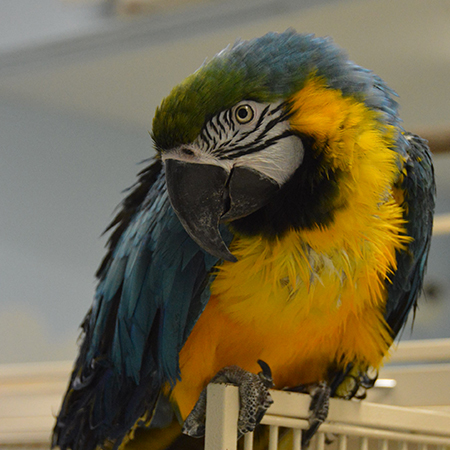Blue and Gold Macaw
Bos primigenius indicus
The blue-and-gold macaw has mostly blue top parts and light orange underparts, with gradient hues of green on top of its head. It is a member of the large group of neotropical parrots known as macaws. In the wild, blue and gold macaws enjoy a wide range from Panama in Central America, extending into almost every country of northern South America. They have also been introduced in Puerto Rico. Blue and golds typically live in the forests near rivers and swamps, though they can be found in savannas if tall trees are available. Most often seen in pairs, the macaws will gather in large flocks at certain times of the year and during morning and evening foraging for food.
These birds can reach a length of 76–86 cm (30–34 in) and weigh 0.900–1.5 kg (2–3 lb), making them some of the larger members of their family. Their sociability and even temperaments mean that blue and golds make great pets. Adding to that, their intelligence, willingness to learn, and talking ability only help make them more precious in the eyes of bird lovers. Like most parrots, the blue and gold thrives on attention from its owner and will form a strong bond with its family members. This is not to say, however, that the blue and gold macaw is for everybody. Indeed, this is a bird that requires extra special attention.

Blue and Gold Macaws are native to South America, ranging across Venezuela to Paraguay. The range extends slightly into Central America.
HABITAT -They typically live in the forests near rivers and swamps, though they can be found in savannas if tall trees are available.
DIET -In the wild they will eat seeds, plant material, fruits, and nuts.
FUN FACT -In the wild they promote forest growth by spreading seeds they eat throughout the forest.
SOCIAL BEHAVIOR -In the wild they form breeding pairs, and flock in large numbers. Can also be social pets.
ACTIVITY -They are diurnal being most active during the day and resting during the evening.
PREDATORS -Predators include birds of prey such as the harpy eagle, hawk eagle, and orange-breasted falcon.
SIZE -These birds can reach a length of 30–34 ins and weigh 2–3 lbs.
RELATIVES -Ara is a neotropical genus of macaws with eight species including the scarlet macaw.
CONSERVATION -Blue and Gold Macaws are categorized as LC (Least Concern) species by the IUCN.
Cub Creek Animal Care Information
Housing - We house our birds in one of our indoor flight enclosures. Our indoor flight enclosures are large rooms with trees, and a new addition to the jungle! We didn’t want our birds to have to spend their days waiting for us to let them out, now they can play around with their other bird friends!
Diet - To ensure he gets all the necessary nutrients, he is fed ZuPreem FruitBlend large bird pellets as well as fresh fruits and vegetables such as apples, bananas, shredded sweet potato, and greens. He also loves getting peanuts as a treat! He is given access to fresh water everyday.
Enrichment - Our blue and gold macaw is well accustomed to human interaction, being comfortable perching around humans. Much of this can be attributed to the continual enrichment through training, and social interaction with humans. During the summer, campers will make all kinds of toys for them, made out of cardboard, or pre-made materials.

